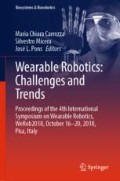Abstract
Exoskeletons were recently proposed to reduce the risk of musculoskeletal disorders for workers. To promote adoption of active exoskeletons in the workplace, control interfaces and strategies have to be designed that overcome practical problems. Open challenges regard sensors invasiveness and complexity, accurate user’s motion detection, and adaptability in adjusting the assistance to address different tasks and users. Focusing on back-support exoskeletons, different control interfaces and strategies are discussed that aim at automatically driving and modulating the assistance, according to the activity the user is performing.
This work is funded by the Italian Workers’ Compensation Authority (INAIL). The authors from Politecnico di Milano were involved through Istituto Italiano di Tecnologia and did not receive any direct funding.
Access this chapter
Tax calculation will be finalised at checkout
Purchases are for personal use only
References
Punnett, L., Wegman, D.H.: Work-related musculoskeletal disorders: the epidemiologic evidence and the debate. J. Electromyogr. Kinesiol. 14(1), 13–23 (2004)
de Looze, M.P., Bosch, T., Krause, F., Stadler, K.S., O’Sullivan, L.W.: Exoskeletons for industrial application and their potential effects on physical work load. Ergonomics 59(5), 671–681 (2016)
INAIL Open Data. https://dati.inail.it
Reeves, N.P., Cholewicki, J.: Modeling the human lumbar spine for assessing spinal loads, stability, and risk of injury. Crit. Rev. Biomed. Eng. 31(1&2), 73–139 (2003)
Tucker, M.R., Olivier, J., Pagel, A., Bleuler, H., Bouri, M., Lambercy, O., del R Millán, J., Riener, R., Vallery, H.: Control strategies for active lower extremity prosthetics and orthotics: a review. J. Neuroeng. Rehabil. 12(1), 1 (2015)
Kobayashi, H. Nozaki, H.: Development of support system for forward tilting of the upper body. In: 2008 IEEE International Conference on Mechatronics and Automation, ICMA 2008. pp. 352–356. IEEE (2008)
Hara, H., Sankai, Y.: Development of HAL for lumbar support. In: SCIS & ISIS/SCIS & ISIS 2010, pp. 416–421. Japan Society for Fuzzy Theory and Intelligent Informatics (2010)
Grazi, L., Crea, S., Parri, A., Yan, T., Cortese, M., Giovacchini, F., Cempini, M., Pasquini, G., Micera, S., Vitiello, N.: Gastrocnemius myoelectric control of a robotic hip exoskeleton. In: 2015 37th Annual International Conference of the IEEE Engineering in Medicine and Biology Society (EMBC), pp. 3881–3884. IEEE (2015)
German Bionic CRAY X. https://www.germanbionic.com/product/
Saccares, L., Brygo, A., Sarakoglou, I., Tsagarakis, N.G.: A novel human effort estimation method for knee assistive exoskeletons. In: 2017 International Conference on Rehabilitation Robotics (ICORR), pp. 1266–1272. IEEE (2017)
Toxiri, S., Koopman, A.S., Lazzaroni, M., Ortiz, J., Power, V., de Looze, M.P., O’Sullivan, L., Caldwell, D.G.: Rationale, implementation and evaluation of assistive strategies for an active back-support exoskeleton. Frontiers in Robotics and AI (in press)
Chen, B., Grazi, L., Lanotte, F., Vitiello, N., Crea, S.: A real-time lift detection strategy for a hip exoskeleton. Front. Neurorobotics 12, 17 (2018)
Author information
Authors and Affiliations
Corresponding author
Editor information
Editors and Affiliations
Rights and permissions
Copyright information
© 2019 Springer Nature Switzerland AG
About this paper
Cite this paper
Lazzaroni, M., Toxiri, S., Caldwell, D.G., De Momi, E., Ortiz, J. (2019). Overview and Challenges for Controlling Back-Support Exoskeletons. In: Carrozza, M., Micera, S., Pons, J. (eds) Wearable Robotics: Challenges and Trends. WeRob 2018. Biosystems & Biorobotics, vol 22. Springer, Cham. https://doi.org/10.1007/978-3-030-01887-0_84
Download citation
DOI: https://doi.org/10.1007/978-3-030-01887-0_84
Published:
Publisher Name: Springer, Cham
Print ISBN: 978-3-030-01886-3
Online ISBN: 978-3-030-01887-0
eBook Packages: EngineeringEngineering (R0)

